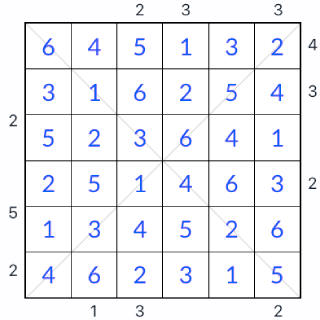Diagonal Consecutive Sudoku Hard
Like this puzzle!
9
1
5
8
4
9
8
5
5
6
8
4
6
3
9
1
6
2
5
5
1
7
9
5
3
1
2
3
4
5
6
7
8
9
?
~
123
1
2
3
Helping solve
Undo
Redo
Delete
0
Hint
Latest score list for #pnejv
pr
premium a second ago
4'55''
Is
Isabella 17 minutes ago
14'35''
Am
Amelia 12 minutes ago
9'30''
re
refinancing 56 minutes ago
5'32''
an
anonymous an hour ago
14'25''
an
anonymous an hour ago
3'38''
pe
petrol an hour ago
16'54''
an
anonymous an hour ago
6'4''
Pr
Prestashop an hour ago
13'51''
in
injury an hour ago
13'45''
Latest score list for Diagonal Consecutive Sudoku
gu
guest solved puzzle No#kdww2;
18'50''
gu
guest solved puzzle No#mn8wz;
10'3''
gu
guest solved puzzle No#3715k;
5'35''
an
anonymous solved puzzle No#3715k;
3'41''
Wo
Workers solved puzzle No#kdww2;
5'58''
an
anonymous solved puzzle No#v0r2z;
17'43''
Em
Emma solved puzzle No#oypwk;
10'58''
da
damage solved puzzle No#lg2v0;
9'22''
bl
blackboard solved puzzle No#kd5k5;
5'8''
gu
guest solved puzzle No#v0r2z;
17'46''
How to play Diagonal Consecutive Sudoku
Diagonal Consecutive Sudoku Rules
Consecutive Sudoku: Standard Sudoku rules apply (1-9 in each row, column, and box) with the added twist of bars between some squares. These bars mean the numbers in those squares must be consecutive (differ by 1).
Diagonal Consecutive Sudoku Additional Rules:
-
Diagonal Sudoku Rule: Sudoku main diagonals also contain the digits 1 through 9.
Read more: Diagonal Consecutive Sudoku rule & tips
Using the Markings:
Pay close attention to the consecutive markers while placing numbers. If two cells are connected by a bar, the numbers you place in them must differ by exactly 1.
Conversely, if there's no marking between two cells, the numbers in those cells cannot be consecutive.
Diagonal Consecutive Sudoku = Diagonal Sudoku + Consecutive Sudoku.
Privacy Policy Copyright Gridpuzzle © 2024



























